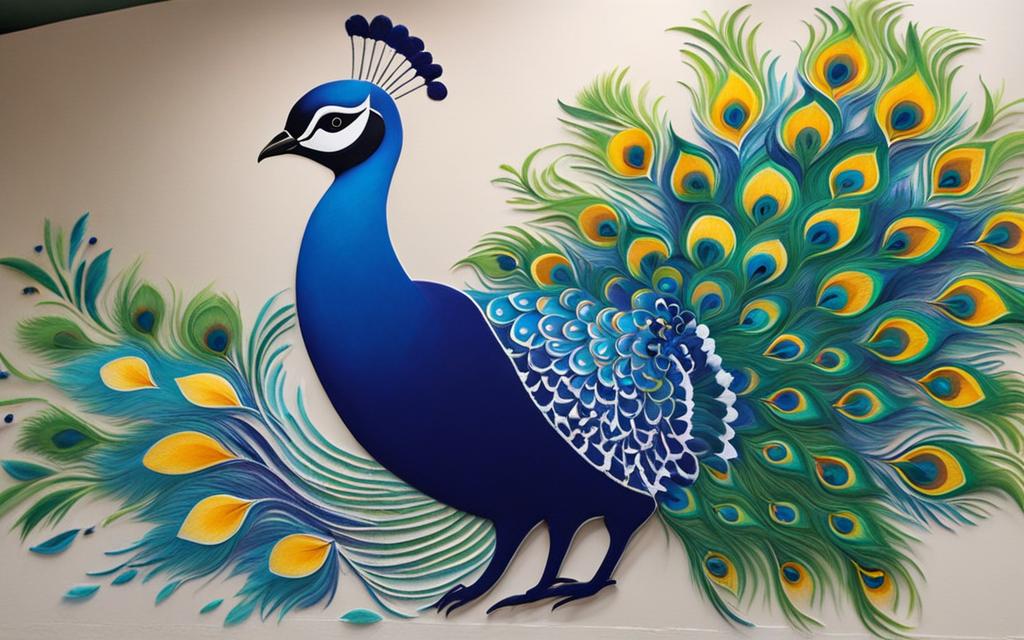The peacock is a symbol of grace, beauty and auspiciousness – perfect for welcoming the festival of lights. This Diwali, adorn your home with elegant peacock rangoli designs that will leave your guests impressed. These creative floor artworks are easier to make than they look.

Table of Contents
How To Make Peacock Rangoli Designs For Diwali – Steps at a Glance
- Lightly sketch the peacock outline before tracing it in white powder
- Use 2-3 main colours to fill alternating feather sections in the body and tail
- Define each feather with fine borders and blend colours gradually
- Embellish with complementary patterns, dots, curlicues and touches
- Relax and enjoy the creative process rather than seeking perfection
Outline the Peacock Shape
- Use a pencil to lightly sketch the peacock outline (with a fanned tail) on your floor space
- Trace along the sketch with white rangoli powder to transfer the outline
- Ensure the outline is clear, taking care of the intricate plumage details
- Fill any enclosed shapes with a different base colour before starting the design
Colour the Peacock’s Feathers
- Use 2-3 rangoli colours to create a vibrant feathered texture within the body
- Employ a circular motion with fingers or tools to complete each feather
- Alternate between hues to establish a definition of feathers
- Blend colours in graded variations for a realistic and 3D effect
- Similarly detail the tail plumage, coordinating colours for cohesion
Embellish with Patterns and Borders
- Outline feathers with thin black or white borders for prominence
- Sprinkle or stencil decorative dots, lines and curls for ornamentation
- Carefully draw patterns like flowers and leaves using rangoli tools
- Accent the peacock’s beak, crest and eyes for lifelike finesse
- Add final embellishments and touches as you prefer around the art
Conclusion – How To Make Peacock Rangoli Designs For Diwali
Rangolis are meant to be fun and meditative. Don’t worry about getting every detail perfect. Just go with the flow as you harmonize colours and patterns to reflect our national bird. Before you know it, a dazzling peacock rangoli will emerge to mesmerize on Diwali night.
>> You may also like:
FAQ – How To Make Peacock Rangoli Designs For Diwali
Q: What’s the best way to outline the peacock shape?
A: Use a pencil to lightly sketch the peacock shape with fanned tail feathers onto your floor first. Then go over the pencil outline with white rangoli powder before colouring inside.
Q: How many colours should I use for the rangoli?
A: Limit yourself to 2 or 3 highly contrasting colours for the best effect. This allows better definition between tail and body feathers.
Q: What basic peacock elements should the design include?
A: Make sure to detail the main feathers, beak, flowing crest, and decorative eyes/patterns on the peacock’s train. Accentuating these makes it more realistic.
Q: Which parts should I emphasize through patterns or borders?
A: Outline individual feathers and accent the tips. Also highlight side plumage, beak and crest with borders. Sprinkled dots, curlicues and leaves further ornament the bird.
Q: How intricate can the detailing get?
A: You can keep surface-level detailing simple for beginner designs. Use basic borders, minimal patterns and just a touch of texture. Elaborate rangolis utilize more complex embellished motifs.
Q: How do I correct mistakes while making the rangoli?
A: Cover and redo small mistakes by sprinkling extra powder. For larger areas, sweep away the section completely and re-fill with fresh borders and colours as needed.
Q: What can I do to enhance my design once complete?
A: Place diyas around it for lighting effects. You can also accent with marigold flowers, and mango leaves or sprinkle additional colours for an ornamental border.
